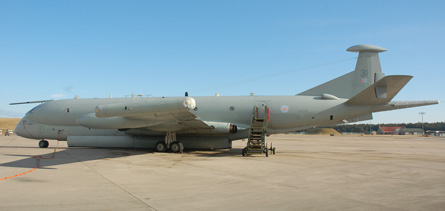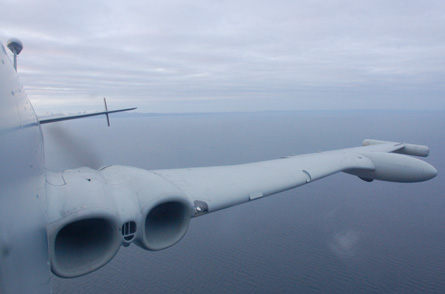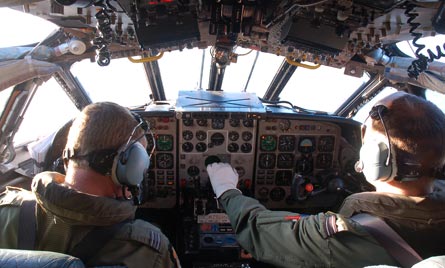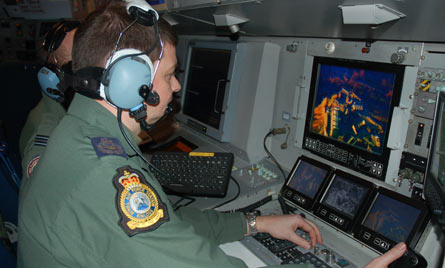Just three weeks before the last operational sortie by a Nimrod MR2 took place, defence editor Craig Hoyle was given the opportunity to fly on board one of the Royal Air Force's remaining examples of the "Mighty Hunter".
Conducted on 10 March using aircraft XV231, the sortie was a continuation training flight for personnel from the RAF's 42(R) Sqn; the operational conversion unit for the retiring maritime patrol aircraft, and in time also for its replacement, BAE Systems' Nimrod MRA4. The crew was supervised by personnel from the standards evaluation unit at RAF Kinloss - the Scottish home of the UK's maritime patrol force.
|
|---|
The MR2 is normally flown with a crew of 12, but "Kinloss 453" took off with a reduced complement of two pilots, one navigator, a flight engineer and four rear crew, plus four passengers.
Piloted by Flt Lt Gary Laing and co-pilot Flt Lt Gordon Fairlie, XV231 took off from Runway 25 at 16:05 local time, with a rotation speed of 122kt (225km/h) and a flap setting of 20°. Our aircraft was carrying 19,050kg (42,000lb) of fuel, and with fine weather conditions, our diversion location was set as Aberdeen airport.
 |
|---|
XV231 was one of the last operational Nimrod MR2s. Photo: Craig Hoyle/Flightglobal |
Unusually short in duration, our flight was expected to last for a little over 3h - around half that of a typical training mission on the type. In addition to evaluating the crew's performance, the sortie was also intended to demonstrate the Nimrod's overland surveillance capabilities, primarily using its L-3 Wescam MX-15 electro-optical/infrared camera. But rather than looking for traditional items of interest, our first "targets" were landmarks in Edinburgh, as the pilots conducted a practice run for a farewell flypast performed over the Calcutta Cup rugby match between Scotland and England at Murrayfield three days later.
|
|---|
The introduction of the MX-15 system under an urgent operational requirement deal to support operations in Afghanistan blurred the boundaries of the MR2's mission, and also that of some of its acoustics operators. These were required to learn a new skill in how to get the best images out of the new sensor's three operating modes, while also retaining their expertise as part of the Nimrod's so-called "wet team". Their "dry" counterparts operate the MR2's electronic support measures equipment, Thales Searchwater maritime surveillance radar and the aircraft's radios.
XV231 was then flown to the Moray Firth to engage in some more traditional work, locating the Royal Fleet Auxiliary vessel Wave Knight and tracking it after dropping several of its Ultra Electronics passive sonobuoys. These can be manually set to operate at one of three selected depths, and have a life of up to 6h.
Information from the sensors was displayed on the MR2's Telephonics AQS-971 acoustics processor - cutting-edge equipment also being integrated with the MRA4 and retrofitted to the older aircraft in response to lengthy delays in introducing the new model.
Next, the MX-15 was put to work in monitoring the Royal Navy aircraft carrier HMS Ark Royal, which had BAE Systems Harrier GR9s and AgustaWestland AW101 Merlin HM1 helicopters operating from it as part of a work-up exercise. This enabled the pilots to put the Nimrod through its paces 500ft (150m) above the water, where it still demonstrates impressive handling, achieving 60° bank angles.
 |
|---|
The Nimrod still feels at home low over the water. Photo: Craig Hoyle/Flightglobal |
Our flight concluded with several circuits at Kinloss due to a high level of activity by migrating geese, which represent a high risk at this time of year. Their threat is taken very seriously, with memories of the 1980 crash which killed both pilots of aircraft XV256 after multiple birdstrikes on take-off from the base.
Source: Flight International


















